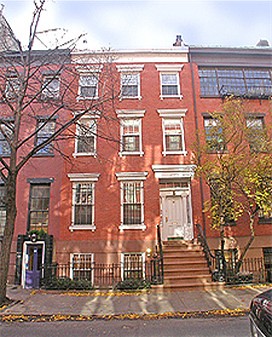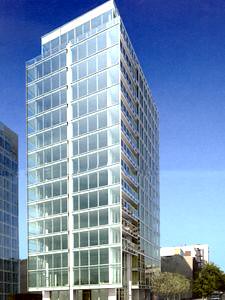Greenwich Village, West Village, East Village
Manhattan Neighborhood Real Estate Report
Manhattan's most famous neighborhood has always been a popular place to live. Greenwich Village is the city's largest historic district.
The Village is bounded to the South by Houston Street, to the North by 14th Street, to the West by the Hudson River, Sixth Avenue divides The West Village and Greenwich Village and east of Broadway is the dividing line between the distinctively different, East Village.
Commonly referred by most people that live in the Village: West of Broadway to be defined as "Greenwich Village", "The Village" or "The West Village" while the area to the East of the Broadway to be defined as the "East Village". So when discussing the "Village", it is commonly understood that one is speaking of the area West of Broadway. Those referring to the "East Village" will always qualify their discussion by using the distinction "East Village".
The Village's informal atmosphere has long attracted those of unconventional thinking-writers, actors, academicians, scholars and artist who preferred to stay well out of the mainstream. New York University, The New School for Social Research and Parson's School of Design all call the Village home.
Edgar Allen Poe, O. Henry, Walt Whitman, and Mark Twain were some of the classic authors who resided in the Village in the 19th century. Norman Rockwell called the village his home in the 20's. Actors and artists such as Dustin Hoffman, Mel Brooks and Bob Dylan were just a few of the many artists who lived in the village in the 60's. Today Nicole Kidman, Calvin Klein and Martha Stewart have bought new condos in the Richard Meier buildings on Perry Street.
Fifth Avenue begins at Washington Square Park in the heart of Greenwich Village.
The prewar and post war coops on lower Fifth Avenue are some of the most desirable buildings in Manhattan. Many of the apartments have spectacular views of Washington Square Park, NYU and lower Manhattan.
Greenwich Village has a charming, small-town feel with its irregular tree-lined streets, brownstone apartment buildings, and elegant town homes. The area is architecturally diverse.
Greenwich Village is New York City on a different scale. The village is one of the most photographed neighborhoods in Manhattan. St Luke's Place is one of Manhattan's most beautiful Streets with trees, old - fashioned street lamps, and elegant brick townhouses in a row. Barrow, Grove, Bedford Commerce Streets are all beautiful charming streets. Wandering through the village is an enclave of townhouses, ivy-covered apartment buildings, cozy courtyards, and mews. Further west there are brick loft apartments and varied architecture.

Much of the West "Village" is not part of the city's rectilinear street grid. It does not go by numbered streets. Some of the city's most delightful, irregular streets are Patchin Place, once the home of E. E. Cummings, the poet, MacDougal Alley, where Gertrude Vanderbilt Whitney's studio was. Washington Mews, lined with former stable buildings for the grand houses facing Washington Square Park.
The Village, of course, is rich in history and many of its famous landmarks are literary and intellectual.The overall charm of the Village is further increased by the many small, European style bistros, cafes and restaurants. Many specialize in French and Italian. They are filled with customers on any given day or night. The Village is filled with bars, saloons, coffeehouses, jazz clubs, experimental theaters, avant-garde clubs, cabarets, funky boutiques and street vendors.
There are more than 100 different clubs and bars in the area offering every type of musical and social entertainment imaginable.
Greenwich Village's many fine restaurants will satisfy a range of tastes as well as budgets.
The Meat Packing District:
For many years Florent, A French bistro/diner in the Meatpacking district was one of the only restaurants in the gritty meatpacking district. It is open 24 hours the food is good but not the thing here, the people watching is superb! Some of the meat packing companies still remain on the cobblestone streets but now Florent and The Meat Packing District is surrounded with trendy restaurants, hotels fashion boutiques and beautiful people.
At the southern end of the High Line, at Gansevoort Street in the Meatpacking District, a new museum and hotel will serve as anchor for the new neighborhood.

<- High Line
Meat Packing District
New designer buildings, new park views, valet parking, concierges, meditation gardens, Manhattan's trendiest new restaurants and art galleres. The grit-and-glamour that New Yorkers love about the meatpacking district is hads expanded northward along the High Line.
New apartment units along the elevated 22-block park the High Line. The High Line runs through three of Manhattans most dynamic neighborhoods, Hells Kitchen, West Chelsea and the Meat Packing District. Plans are underway to transform a 6.7acre span of former elevated train track running 22 blocks into an open park.
The Far West Village:
Luxurious new condominiums along West Street outside the historic district feature spectacular river views, full floor raw space and designed apartments have become a new destination.
Manhattan's most famous neighborhood has always been a popular place to live. Greenwich Village is the city's largest historic district.
The Village is bounded to the South by Houston Street, to the North by 14th Street, to the West by the Hudson River, Sixth Avenue divides The West Village and Greenwich Village and east of Broadway is the dividing line between the distinctively different, East Village.
Commonly referred by most people that live in the Village: West of Broadway to be defined as "Greenwich Village", "The Village" or "The West Village" while the area to the East of the Broadway to be defined as the "East Village". So when discussing the "Village", it is commonly understood that one is speaking of the area West of Broadway. Those referring to the "East Village" will always qualify their discussion by using the distinction "East Village".
The Village's informal atmosphere has long attracted those of unconventional thinking-writers, actors, academicians, scholars and artist who preferred to stay well out of the mainstream. New York University, The New School for Social Research and Parson's School of Design all call the Village home.
 |
| Christopher Park |
 |
| Arch Washington Square Park |
Fifth Avenue begins at Washington Square Park in the heart of Greenwich Village.
The prewar and post war coops on lower Fifth Avenue are some of the most desirable buildings in Manhattan. Many of the apartments have spectacular views of Washington Square Park, NYU and lower Manhattan.
Greenwich Village has a charming, small-town feel with its irregular tree-lined streets, brownstone apartment buildings, and elegant town homes. The area is architecturally diverse.
Greenwich Village is New York City on a different scale. The village is one of the most photographed neighborhoods in Manhattan. St Luke's Place is one of Manhattan's most beautiful Streets with trees, old - fashioned street lamps, and elegant brick townhouses in a row. Barrow, Grove, Bedford Commerce Streets are all beautiful charming streets. Wandering through the village is an enclave of townhouses, ivy-covered apartment buildings, cozy courtyards, and mews. Further west there are brick loft apartments and varied architecture.

Much of the West "Village" is not part of the city's rectilinear street grid. It does not go by numbered streets. Some of the city's most delightful, irregular streets are Patchin Place, once the home of E. E. Cummings, the poet, MacDougal Alley, where Gertrude Vanderbilt Whitney's studio was. Washington Mews, lined with former stable buildings for the grand houses facing Washington Square Park.
The Village, of course, is rich in history and many of its famous landmarks are literary and intellectual.The overall charm of the Village is further increased by the many small, European style bistros, cafes and restaurants. Many specialize in French and Italian. They are filled with customers on any given day or night. The Village is filled with bars, saloons, coffeehouses, jazz clubs, experimental theaters, avant-garde clubs, cabarets, funky boutiques and street vendors.
There are more than 100 different clubs and bars in the area offering every type of musical and social entertainment imaginable.
Greenwich Village's many fine restaurants will satisfy a range of tastes as well as budgets.
The Meat Packing District:
For many years Florent, A French bistro/diner in the Meatpacking district was one of the only restaurants in the gritty meatpacking district. It is open 24 hours the food is good but not the thing here, the people watching is superb! Some of the meat packing companies still remain on the cobblestone streets but now Florent and The Meat Packing District is surrounded with trendy restaurants, hotels fashion boutiques and beautiful people.
At the southern end of the High Line, at Gansevoort Street in the Meatpacking District, a new museum and hotel will serve as anchor for the new neighborhood.

<- High Line
Meat Packing District
New designer buildings, new park views, valet parking, concierges, meditation gardens, Manhattan's trendiest new restaurants and art galleres. The grit-and-glamour that New Yorkers love about the meatpacking district is hads expanded northward along the High Line.
New apartment units along the elevated 22-block park the High Line. The High Line runs through three of Manhattans most dynamic neighborhoods, Hells Kitchen, West Chelsea and the Meat Packing District. Plans are underway to transform a 6.7acre span of former elevated train track running 22 blocks into an open park.
The Far West Village:

Luxurious new condominiums along West Street outside the historic district feature spectacular river views, full floor raw space and designed apartments have become a new destination.












Florent has been closed for a while now..I think over a year.Miss that place!
ReplyDeleteCheers..
Tony(NYC)
Hi Tony, Thanks for the comment. I miss the place too. I posted a tribute to Florent.
ReplyDeletehttp://nycblogestate.com/2008/06/end-of-era-in-meat-packing-district.html